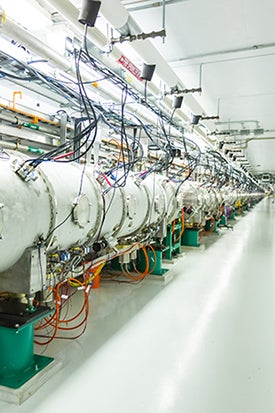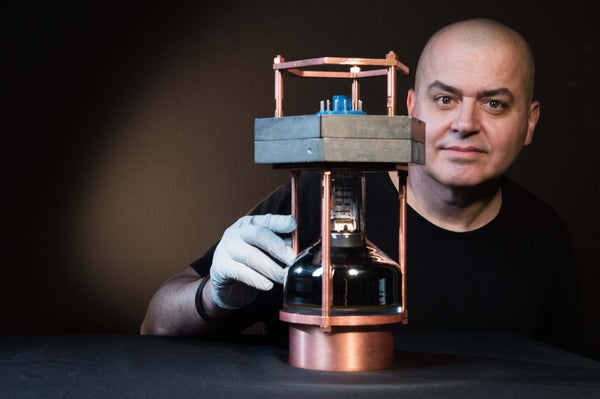Neutrinos are famously antisocial. Of all the characters in the particle physics cast, they are the most reluctant to interact with other particles. Among the hundred trillion neutrinos that pass through you every second, only about one per week actually grazes a particle in your body.
That rarity has made life miserable for physicists, who resort to building huge underground detectortanks for a chance at catching the odd neutrino. But in a study published today in Science, researchers working at Oak Ridge National Laboratory (ORNL) detected never-before-seen neutrino interactions using a detector the size of a fire extinguisher. Their feat paves the way for new supernova research, dark matter searches and even nuclear nonproliferation monitoring.
Under previous approaches, a neutrino reveals itself by stumbling across a proton or neutron amidst the vast emptiness surrounding atomic nuclei, producing a flash of light or a single-atom chemical change. But neutrinos deign to communicate with other particles only via the “weak” force—the fundamental force that causes radioactive materials to decay. Because the weak force operates only at subatomic distances, the odds of a tiny neutrino bouncing off of an individual neutron or proton are minuscule. Physicists must compensate by offering thousands of tons of atoms for passing neutrinos to strike.
On supporting science journalism
If you're enjoying this article, consider supporting our award-winning journalism by subscribing. By purchasing a subscription you are helping to ensure the future of impactful stories about the discoveries and ideas shaping our world today.
The new experimental collaboration, known as COHERENT, instead looks for a phenomenon called CEvNS (pronounced “sevens”), or coherent elastic neutrino-nucleus scattering. CEvNS relies on the quantum mechanical equivalence between particles and waves, comparable to ocean waves. The high-energy neutrinos sought by most experiments are like short, choppy ocean waves. When such narrow waves pass under floating debris, they can pick out one leaf or twig at a time to toss around. Similarly, a high-energy neutrino typically picks out individual protons and neutrons with which to interact. But just as a long, slow wave would pick up the whole patch of debris at once, a low-energy neutrino sees the entire atomic nucleus as one “coherent” whole. This dramatically improves the odds of an interaction. As the number of neutrons in the nucleus is increased, the effective target size for the neutrino to hit grows in lockstep not just with that number, but with its square.
Of course, once a neutrino and a nucleus collide, the collision must still be detected. The neutrino bounces off and continues its inscrutable wandering but the nucleus also recoils slightly from the impact. That jolt kicks a few electrons out of their orbits around the nucleus and its neighbors. As the electrons fall back into place, they release their acquired energy as photons. Each burst of photons is the calling card of a neutrino.
Down Neutrino Alley
Although they are orders of magnitude more common than other neutrino collisions, CEvNS interactions pose formidable challenges to detection—so much so that no study has observed them since the mechanism was first theorized 43 years ago. COHERENT owes its success to its choices of neutrino source and target material—plus an unexpected assist from a cramped basement hallway.
The first problem facing COHERENT was the sheer tininess of a nuclear recoil. “Imagine that you take a ping-pong ball and you throw it at a bowling ball,” says Temple University physics professor Jim Napolitano, who was not involved in the study. “We know from conservation of momentum [that] a little bit of energy is imparted to the bowling ball. This [experiment] is detecting that bowling ball’s energy”—a signal on the order of 10 photons.
The challenge for COHERENT, then, was to find a material with atomic nuclei large enough for neutrinos to hit easily, but also small enough that they would noticeably recoil on impact. In addition, the material had to be transparent so the photons could reach the detectors. “That took me a lot of thinking—maybe 15 years,” says Juan Collar, a professor of physics at the University of Chicago and one of the study’s lead authors.
The second constraint was the neutrinos themselves. In theory, a recoil from a fast-moving neutrino would be larger, and therefore easier to spot—but if the neutrinos were too speedy, they would have too much energy to interact coherently. Eventually Collar and his colleagues realized that sodium-doped cesium iodine, a transparent crystalline material, would be an ideal target for the neutrinos that are produced as a by-product by the Spallation Neutron Source (SNS), a neutron-producing particle collider at ORNL.

Cryomodules for SNS’s particle accelerator, which produces neutrons for distribution along beam lines to experimental stations. The same process that produces the neutrons also spits out neutrinos, which enter the COHERENT detector in the SNS basement. Credit: Jean Lachat University of Chicago
But using the SNS as a neutrino source added a third complication. Neutrons can be convincing mimics of neutrinos: They have no charge, so they do not show up on electromagnetic detectors, and they can strike a nucleus with the same effects as a neutrino. When the COHERENT team first tested the SNS grounds, says co-author David Reyna of Sandia National Laboratories, they found neutrons streaming out of the SNS’s neutron generation site, as expected—but also pouring through the shielding of neighboring experimental halls. The detector noise from neutrons was so bad that the researchers feared they might not be able to use the facility at all.
Fortunately, ORNL professor of particle physics Yuri Efremenko made a lucky discovery: a basement hallway beneath the SNS collider. Despite being close to the neutron source, it happened to be shielded by the densely compacted earth supporting the collider’s many tons of concrete. After negotiations with ORNL’s safety team, the COHERENT team removed the empty drums that had been stored in the hallway and set up shop in their new “neutrino alley.”
A Future Full of Neutrinos
Experts have only glowing words for the COHERENT result. Massachusetts Institute of Technology physics professor Janet Conrad says she is “really, really pleased.” Napolitano calls the paper “monumental” and “a huge accomplishment.” And no outside expert who spoke with Scientific American expressed any technical quibbles with the paper. With such a convincing demonstration of the CEvNS phenomenon, scientists can now turn from finding it to using it.
The biggest implication is having what Collar calls a “handheld neutrino detector.” The compact size will be a huge boon to neutrino researchers; Conrad notes that one of her previous experiments had “mini” in its name despite being 40 feet tall. (Larger detectors will still be useful for studying neutrino properties that cannot be measured with CEvNS.) Small detectors could also eventually assist the International Atomic Energy Agency in monitoring nuclear reactors for clandestine production of fuel for atomic weapons, Reyna says. The neutrinos pumped out by reactor cores cannot be shielded or hidden, so if CEvNS detectors can be adapted to spot these lower-energy neutrinos, inspectors could check remotely whether a reactor’s activities match its operators’ claims.
The CEvNS phenomenon itself also opens up new scientific frontiers. Collar and his colleagues are already working to test whether the rates of neutrino detection in different materials match theoretical predictions. Those same theories govern what happens in supernovae, which release 99 percent of their energy as neutrinos. That means further CEvNS experiments, in addition to detecting supernovae, could confirm or refute models of these colossal stellar explosions. And dark matter researchers are breathing a sigh of relief, because a close cousin of CEvNS could bolster ongoing searches for a hypothesized form of dark matter called weakly interacting massive particles (WIMPs). COHERENT’s discovery bolsters the viability of the WIMP theory, says Collar, and points the way to future detection technologies.
All these potential advances give physicists plenty to be excited about, says University of Michigan physicist Josh Spitz. “This [study] is just the tip of the iceberg. There’s a whole lot more interesting stuff to come.”
